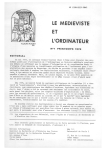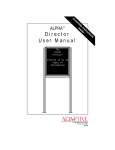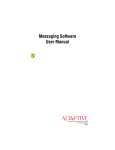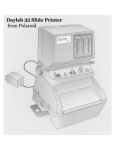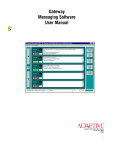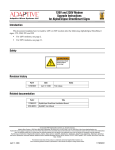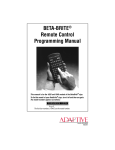Download Adaptive Micro Systems Solar Specifications
Transcript
PROGRAMMING MANUAL Form No. 9703-6001D 11/13/98 i NOTE: Due to continuing product innovation, specifications in this document are subject to change without notice. Copyright © 1998 Adaptive Micro Systems, Inc. All rights reserved. The distinctive appearance of this product is a Trade Dress of Adaptive Micro Systems, Inc. BETA-BRITE, BIG DOT, and SMART ALEC are trademarks of Adaptive Micro Systems, Inc. registered in the United States Patent and Trademark Office. Alec, ALPHA, AlphaLert, AlphaNET, AlphaNET plus, AlphaNET plus II, ALPHAVISION, Automode, Director, EZ KEY II, EZ95, PagerNET, PrintPak, PPD, Solar, and TimeNet are trademarks of Adaptive Micro Systems, Inc. Visit our Internet World Wide Web site: http://www.ams-i.com or e-mail us at [email protected] ii Contents General information ...................................................................... 1 Using a Remote Control to operate your sign..................................................1 Using a computer to operate your sign ...........................................................2 Attaching your sign to a surface......................................................................3 Technical specifications...................................................................................5 EMI information ..............................................................................................5 Basic sign operation ..................................................................... 6 Turning a sign on and off.................................................................................6 Setting a sign’s time and date..........................................................................7 Clearing a sign’s memory ................................................................................8 Setting a sign’s password................................................................................9 What to do when you forget a sign’s password......................................10 How to delete a sign’s password ............................................................10 Sound control................................................................................................10 Beginning text messaging..............................................................11 Example 1 — Using upper and lowercase in messages ................................11 Example 2 — Displaying messages in file name order (A, B, C, etc.)............13 Example 3 — Displaying messages in time order .........................................15 Example 4 — Changing the text of an existing message ...............................17 Example 5 — Deleting messages ..................................................................20 Advanced text messaging ..............................................................21 Example 6 — Displaying the time and date ...................................................21 Example 7 — Using fonts and colors ............................................................24 Example 8 — Speeding up and slowing down messages .............................27 Example 9 — Special effects with modes (Trailing modes)...........................29 Example 10 — International characters ........................................................30 Graphics ...................................................................................32 Example 11 — Creating a movie marquee ....................................................32 Example 12 — Mixing text with graphics ......................................................37 Example 13 — Deleting a graphic .................................................................39 Appendixes ...............................................................................40 Appendix A — Modes, fonts, colors, and graphics available.........................40 Appendix B — Sign diagnostic test ...............................................................45 iii WARNING FOR EUROPEAN USERS This is a class A product. In a domestic environment, this product may cause radio interference, in which case the user may be required to take adequate measures. iv BETA BRITE Programming Manual General information You can operate a BETA BRITE sign in two ways: • by using a hand-held Remote Control • by using personal computer Using a Remote Control to operate your sign A Remote Control is a hand-held keyboard used to operate a BETA BRITE sign. Most of this manual shows you how to program messages on your sign using a Remote Control. A Remote Control needs two AA batteries to operate. Press PROGRAM to put the sign into one of these modes: (Use BACK to move from mode to mode and ADV to select a mode.) • PROG TEXT A – for entering text messages. (“A” is a file name, from A to Z.) • PROG DOTS A – for creating graphics. (“A” is a file name, from A to Z.) • SET TIME – changes the sign’s time. • SET DATE – changes the sign’s date. • SET PASSWORD – used to prevent someone from changing your messages. • CLEAR MEMORY – deletes all text and graphic files. Point this end of the Remote Control at the front of your BETA BRITE. ON/OFF CAPS LOCK SOUND PROGRAM MODE FONT FCN RUN 1 2 3 4 5 6 7 8 9 0 A B C D E F G H I J K L M N O P Q R S T U V W X Y Z SPACE RETURN COLOR SYMBOL APPEND TIME/DATE SPEED DOTS ! BACK ADV SELECT DELETE Use SPACE to insert a blank space between characters. (To insert just a half space, press SELECT.) Hold down FCN and then press PROGRAM to turn the sign off and on. INSERT Press RUN twice to exit programming mode. These keys with red triangles are used in PROG DOTS to draw graphics. (Press SELECT to turn drawing on and off.) HOW TO ENTER A MESSAGE: 1. POINT THIS REMOTE CONTROL KEYBOARD AT THE DISPLAY. 2. PRESS THE PROGRAM KEY. THE WORDS "PROG TEXT" WILL APPEAR ON THE DISPLAY. 3. ENTER THE MESSAGE YOU WANT TO BE DISPLAYED. (USE THE ! AND SELECT KEYS FOR PUNCTUATION). 4. PRESS THE RUN KEY TWICE. SEE YOUR PROGRAMMING MANUAL FOR ADDITIONAL INSTRUCTIONS AND DISPLAY FEATURES. General information: Using a Remote Control to operate your sign To type a special character (like ? or !) or a graphic symbol, press SYMBOL or !. Then press SELECT to choose a special character or graphic. 1 BETA BRITE Programming Manual Using a computer to operate your sign Though messages can be programmed into the sign using the handheld Remote Control, messages can also be sent to the sign using a computer. To do this, you’ll need special connectors and computer software: A B To the sign’s RS232 jack (on the side) To power source C To one of the PC’s COM (RS232) ports PC running AlphaNET software D NOTE: Do NOT connect a telephone to the sign’s RS232 jack. NOTE: Do NOT use ordinary telephone wire to connect the sign to a computer. NOTE: Use only the power supply (Item D) that came with the sign. NOTE: All of the parts listed below (including the AlphaNET software) are available from Adaptive Micro Systems. Item A B C D Part # — 1088-8625 1088-8627 4370-0001C 1088-9108 — Description Ferrite (ferrite end towards sign) 25-foot 6-conductor RS232 data cable 50-foot 6-conductor RS232 data cable 25 pin sub-D/to 6 pos. RJ11 adapter 9 pin sub-D/to 6 pos. RJ11 adapter Power supply NOTE: This manual shows you how to send messages to your sign with the Remote Control. The manual that comes with the AlphaNET software shows you how to send messages to your sign with a computer. 2 General information: Using a computer to operate your sign BETA BRITE Programming Manual Attaching your sign to a surface Your sign can be mounted on a wall, ceiling, or counter. NOTE: This sign is intended for indoor use only. NOTE: • Do not mount or attach the power supply to anything. • Do not let the power supply hang loose. • Place the power supply on a flat surface where no chemicals or liquid, such as water, will contact it. • Plug the power supply into an easily-accessible electrical outlet no further than 15 feet away from the sign. Wall mount 1. 2. 3. Screw Attach the mounting brackets to the wall or surface, 24 5/8 inches (62.7 cm) on center. Attach the sign to mounting brackets using hardware as shown. Plug the power cord into the sign and into an outlet. Lock washer Bracket Bracket Washer Washer Lock washer Screw Power cord Top view Front view General information: Attaching your sign to a surface 3 BETA BRITE Programming Manual Ceiling mount 1. 2. 3. Attach the ceiling brackets to the sign using the screws supplied. Hang the sign from the ceiling using mounting chains and ceiling hooks (not supplied). The chains and hooks must be able to support at least four times the weight of the sign. Plug the power cord into the sign and into a nearby outlet. Top view Ceiling bracket X Side view X Ceiling This mounting chain and ceiling hook (not supplied) must be able to support at least four times the weight of the sign. Counter mount 1. 2. 3. 4. Screw Front view Attach the mounting brackets to the counter, 24 5/8 inches (62.7 cm) on center. Plug the power cord into the sign. Attach the sign to mounting brackets using hardware as shown. NOTE: On the end with the power cord, use the spacer proviced, not a washer. Plug the power cord into an outlet. Lock washer Bracket Bracket Spacer Washer Lock washer Screw Power cord Top view Front view 4 General information: Attaching your sign to a surface BETA BRITE Programming Manual Technical specifications Weight 2.55 pounds (1.16 kg) (without power supply or keyboard): Height: 3 13/16 inches (9.7 cm) Length: 25 7/8 inches (65.7 cm) Depth: 1 15/16 (3.4 cm) Power: 7.5 VDC at 3.25A The display should be operated in an environment Environmental requirements: where the temperature is between 0° C and 45° C, and the humidity (non-condensing) does not exceed 95%. EMI information Electromagnetic interference (EMI) information follows: United States This device complies with Part 15 of the FCC rules. Operation is subject to the following two conditions: (1) This device may not cause harmful interference. (2) This device must accept any interference received, including interference that may cause undesired operation. Canada This Class A digital apparatus meets all requirements of the Canadian Interference-Causing Equipment Regulations. Cet appareil numerique de la class A respecte toutes les exigences du Regement sur le material broullieur du Canada. General information: Technical specifications 5 BETA BRITE Programming Manual Basic sign operation Turning a sign on and off When you plug in the sign’s power supply, the sign starts up automatically, and unplugging the power supply turns the sign off. However, instead of unplugging a sign, there is another way to turn the sign off: Holding down FCN and then press PROGRAM turns a sign off and on. NOTE: Messages that you have programmed into the sign will not be lost when you turn a sign off. Messages will be retained for up to 30 days if the sign is not powered. When a signs starts up, the following will be displayed: 1036-0001A The software (or “firmware”) version inside the sign. THEN 32K RAM The amount of memory inside the sign. THEN WED 1:26 PM 6 The time and date of the sign. Basic sign operation: Turning a sign on and off BETA BRITE Programming Manual Setting a sign’s time and date Once set, a sign will remember the time and date unless the sign is unplugged or interrupted by a power loss. NOTE: Because the time and date are not updated when the sign is off, the time and date must be re-programmed each time the sign is turned off and on. Step When you do this... 1 Press PROGRAM. 2 Press BACK until SET TIME appears. You see this... PROG TEXT A SET TIME SET W/D ,H&M 3 Press ADV. THEN MON 2:29 AM 4 Press D to set the day of the week. Press H to set the hour. Press M to set the minute. TUE 11:21 AM NOTE:Press SELECT, to change from 12-hour (AM/PM) to 24-hour mode (0 - 23). 5 Press BACK until SET DATE appears. 6 Press ADV. SET DATE SET WITH D,M,&Y THEN JAN. 1 ,1998 Press D to set the day. Press M to set the month. Press Y to set the year. 7 NOTE:Press SELECT to display the date in different formats—for example, JAN 26, 1998 or 1/26/98, or 26/1/98, etc. OCT. 14 ,1998 After setting the date and time, press RUN twice to return to normal operation. 8 NOTE:Date and Time will not appear on the screen after you have returned to normal operation. Basic sign operation: Setting a sign’s time and date 7 BETA BRITE Programming Manual Clearing a sign’s memory Clearing a sign’s memory erases all messages and graphics that have been programmed into the sign — also, the sign’s password (if any) will be deleted. Step When you do this... 1 Press PROGRAM. 2 Press BACK until CLEAR MEMORY appears. 3 Press ADV. You see this... PROG TEXT A CLEAR MEMORY WARNING! THEN CLEAR ALL? Y/N 4 8 Press Y to clear the sign’s memory. The sign will return to normal operation and display a series of demo messages. Basic sign operation: Clearing a sign’s memory BETA BRITE Programming Manual Setting a sign’s password You can set a personal password to protect your messages and graphics from tampering by others. If you forget the password, see “What to do when you forget a sign’s password” on page 10. Step When you do this... You see this... PROG TEXT A 1 Press PROGRAM. 2 Press BACK until SET PASSWORD appears. SET PASSWORD 3 Press ADV. SET PASSWORD? Y/N 4 Press Y to set a password. Type a 6-character password. (Only asterisks will appear on the sign as you type.) ENTER 6 CHAR’S ****** RE-ENTER THE 6 Re-type the password when prompted. THEN ****** 5 THEN CORRECT will appear if you entered the same password. CORRECT THEN If you failed to type the same password, ERROR will appear, and you’ll have to start over from Step 1. 6 PROG TEXT A Press RUN twice. PASSWORD RUN? Y/N Press Y to password protect the sign. SECURE The sign will return to normal operation. 7 NOTE:If you select N, then a password will not be needed when you press PROGRAM. Basic sign operation: Setting a sign’s password Now, whenever you press PROGRAM, you’ll have to type the password you just entered. 9 BETA BRITE Programming Manual What to do when you forget a sign’s password Step 1 When you do this... Press PROGRAM. You see this... ENTER PASSWORD ****** 2 Press L six times. CORRECT THEN PROG TEXT A 3 Enter a new password. (See “Setting a sign’s password” on page 9.) How to delete a sign’s password If you no longer want to be prompted to password protect a sign, you must clear the sign’s memory in order to delete the password. To do this, see “Clearing a sign’s memory” on page 8. Sound control Normally, when you press a Remote Control key while programming a sign, the sign will beep. If you want to turn the beeping off, hold down FCN and then press FONT. (To turn the beeping on again, repeat this.) 10 Basic sign operation: Sound control BETA BRITE Programming Manual Beginning text messaging This section shows you how to start creating messages on your sign. Example 1 — Using upper and lowercase in messages In this first example, you’ll display the text THIS IS YOUR FIRST MESSAGE like this: THIS IS YOUR Your first message will look like this. THEN FIRST MESSAGE . . . and then the text This is your second message: This is your THEN second This message must be shown on three displays because the words “second message” won’t fit on a single line. THEN message Step When you do this... 1 Press PROGRAM. 2 Press ADV. Your second message will use lowercase text. You see this... PROG TEXT A A] “A” is the file name of your message A] [AUT]T Type THIS IS YOUR FIRST MESSAGE 3 Note: If you make a mistake while typing, press DELETE to erase a letter. [AUT], which stands for Automode, will appear as you type your first character. Automode automatically displays your message in different formats. Your message should look like this when you’re done typing. A] IRST MESSAGE Beginning text messaging: Example 1 — Using upper and lowercase in messages 11 BETA BRITE Programming Manual THIS IS YOUR THEN 4 Press RUN twice. FIRST MESSAGE Because Automode [AUT] was used in your message (see Step 3), the text of your message will be displayed in a variety of formats. For example, one of the formats (or modes) called Scroll moves your message from the bottom to the top of the sign. Now that the first message is done, we’ll enter a second message which contains upper and lowercase characters. 5 Press PROGRAM again. 6 Press SELECT. PROG TEXT A PROG TEXT ? The A changes to a question mark (?) after pressing SELECT. B] 7 Press B. “B” is now the file name of your second message. If you pressed A instead of B, you would have written over the first message. Type T 8 Hold down FCN and then press MODE to switch to lowercase letters. B]cond message Your message should look like this when you’re done typing. Type his is your second message This is your THEN second 9 Press RUN twice. THEN message You should notice that . . . • The first message doesn’t appear at all. (We’ll fix this in the following example.) 12 Beginning text messaging: Example 1 — Using upper and lowercase in messages BETA BRITE Programming Manual Example 2 — Displaying messages in file name order (A, B, C, etc.) Once you’ve programmed messages into the sign, you may want to set the order or sequence in which messages appear. In this example, we’ll display messages by their file name (A, B, C, etc.) or in alphabetical order. Step When you do this... You see this... This example continues where Example 1 left off. This example assumes that there are two messages (files A and B) in the sign: File A = THIS IS YOUR FIRST MESSAGE File B = This is your second message 1 Press PROGRAM. 2 Press RUN. PROG TEXT B RUN TIME or DEMO may also appear here. If RUN appears on the sign, go to the next step. RUN 3 Otherwise, press SELECT until RUN appears. 4 Press B. B RUN This is your THEN 5 second Press RUN. THEN message You have just programmed the sign to run only message file B. Next, we’ll program the sign to display message B and then message A. 6 Press PROGRAM. 7 Press RUN. PROG TEXT A RUN Beginning text messaging: Example 2 — Displaying messages in file name order (A, B, C, etc.) 13 BETA BRITE Programming Manual If RUN appears on the sign, go to the next step. 8 RUN Press SELECT until RUN appears. BA RUN 9 Press B, then A. The order of these letters determines the order in which messages will appear on a sign. (In this case, message B will appear first, then message A.) This is your File B THEN second THEN message 10 THEN Press RUN. File A THIS IS YOUR THEN FIRST MESSAGE These two messages will keep being displayed in this order until a new file name order or a new message is entered. Using this method, you can program the order of some or all of the messages you’ve entered on a sign. 14 Beginning text messaging: Example 2 — Displaying messages in file name order (A, B, C, etc.) BETA BRITE Programming Manual Example 3 — Displaying messages in time order In Example 2, you set the order of messages by file name. However, that method could not specify an exact time when a message would appear. In this example, we’ll show you how to make a message appear and disappear at times you specify. NOTE: Displaying messages in time order will work only as long as the sign has power. When your sign loses power, its internal clock becomes inaccurate and must be reset (see “Setting a sign’s time and date” on page 7). Step When you do this... You see this... For this example, make sure that your sign’s internal clock has been accurately set. (See “Setting a sign’s time and date” on page 7.) This example continues where Example 1 left off. This example assumes that there are two messages (files A and B) in the sign: File A = THIS IS YOUR FIRST MESSAGE File B = This is your second message In this example, we’ll program the sign to display File A from Monday through Friday from 1:10 PM to 2:30 PM. We’ll program the sign to always display File B. 1 Press PROGRAM. PROG TEXT A 2 Press SELECT until B appears. PROG TEXT B 3 Press TIME/DATE. 4 Press PROGRAM. PROG TEXT B 5 Press SELECT until A appears. PROG TEXT A B ON ALWAYS Since file B is already set up, we’ll go on to file A. ON ALWAYS is the default setting for a message. A message set to ON ALWAYS will run continuously. A ON ALWAYS 6 Press TIME/DATE. First, we’ll select the ON time or when the message starts. Beginning text messaging: Example 3 — Displaying messages in time order 15 BETA BRITE Programming Manual 7 8 A ON M-F 0:00 Press D (for day) until M-F (Monday through Friday) appears. Press D to set the day, H for hour, and M for minute (in 10-minute increments). A ON M-F 13:00 Press H (for hour) until 13:00 appears. Hours must be represented in 24-hour or military style. So 1:00 PM = 13:00, 2:00 PM = 14:00, etc. 9 A ON M-F 13:10 Press M (for minute) until 13:10 appears. Minutes are set in increments of 10. 10 A OFF M-F 0:00 Press SELECT. After setting the ON time, select the OFF time or when the message stops. 11 Repeat Steps 7, 8, and 9 to set the OFF time (2:30 or 14:30 in this example.) 12 Press RUN once. (If TIME does not appear, press SELECT until it does.) 13 TIME RUN or DEMO may also appear here. Press AB. TIME AB This is your THEN File B This message should appear continuously. second THEN 14 message Press RUN once. THEN 16 THIS IS YOUR File A This message should only appear between the ON and OFF times you set. THEN FIRST MESSAGE Beginning text messaging: Example 3 — Displaying messages in time order BETA BRITE Programming Manual Example 4 — Changing the text of an existing message After typing in a message, you may want to add or remove text from it. The following is an example of this common situation: Step When you do this... You see this... This example continues where Example 2 left off. This example assumes that there are two messages (files A and B) in the sign: File A = THIS IS YOUR FIRST MESSAGE File B = This is your second message and that File A, then File B is displayed. In this example, we’ll change File A and File B to the following: File A = THIS IS YOUR FIRST MESSAGE, BUT NOW IT’S LONGER File B = This is the second message ( your changed to the ) 1 Press PROGRAM. PROG TEXT A 2 Press SELECT until B appears. PROG TEXT B 3 Press ADV until the space after your appears. B] This is your We’re going to delete your and replace it with the. 4 Press DELETE until your (and the space after it) are erased. B] [AUT]This INSERT 5 T]This is is Press INSERT. Text you type now will be inserted here—after the space following is. 6 Type the (and then SPACE). INSERT 7 Press INSERT to turn text insertion off. B] 8 Press ADV until the first few letters of second appear. is is the T]This is the B] is is the sec the has replaced your Beginning text messaging: Example 4 — Changing the text of an existing message 17 BETA BRITE Programming Manual Press APPEND to go to the end of the message. 9 B] cond message DON’T OMIT THIS STEP. If you do, the last part of the message will be automatically deleted. This is the Press RUN twice. File B THEN 10 second THEN message Next, we’ll add text to the end of File A. 11 Press PROGRAM. PROG TEXT B 12 Press SELECT until A appears on the sign. PROG TEXT A 13 Press APPEND. 14 To type a comma, press ! and then SELECT until a comma appears. 15 Press SPACE and then type BUT NOW IT. A] E, BUT NOW IT 16 Press ! and then SELECT until an apostrophe appears. A] , BUT NOW IT’ 17 Type S LONGER. A] W IT’S LONGER A] IRST MESSAGE APPEND takes you to the end of a message. 18 A]IRST MESSAGE, Beginning text messaging: Example 4 — Changing the text of an existing message BETA BRITE Programming Manual THIS IS YOUR THEN 18 Press RUN twice. File A FIRST MESSAGE THEN BUT NOW IT’S THEN LONGER Beginning text messaging: Example 4 — Changing the text of an existing message 19 BETA BRITE Programming Manual Example 5 — Deleting messages To delete all the messages in a sign, see “Clearing a sign’s memory” on page 8. However, if you only want to delete selected messages, then use the method shown in this example. Step When you do this... You see this... This example continues where Example 4 left off. This example assumes that there are two messages (files A and B) in the sign: File A = THIS IS YOUR FIRST MESSAGE, BUT NOW IT’S LONGER File B = This is the second message In this example, we’ll delete File B. 1 Press PROGRAM. PROG TEXT A 2 Press SELECT until B appears on the sign. PROG TEXT B 3 Press DELETE. 4 Press Y to delete the file. DEL TEXT B? Y/N PROG TEXT A THIS IS YOUR THEN 5 Press RUN twice. File A FIRST MESSAGE THEN BUT NOW IT’S THEN LONGER 20 Beginning text messaging: Example 5 — Deleting messages BETA BRITE Programming Manual Advanced text messaging Before attempting the following, make sure you’re familiar with the previous examples in the “Beginning text messaging” section of this manual. Example 6 — Displaying the time and date NOTE: Because the time and date are not updated when the sign is off, the time and date must be re-programmed each time the sign is turned off and on. Step When you do this... You see this... In this example, we’ll create a message that continuously displays the current time and date: Rosco THEN Advertising THEN The time will be displayed in wide letters. 3:26 PM THEN Oct. 14 ,1997 1 Delete all the messages currently stored in the sign. (See “Clearing a sign’s memory” on page 8 or “Example 5 — Deleting messages” on page 20.) 2 Press PROGRAM. PROG TEXT A 3 Press SELECT. PROG TEXT ? 4 Press A. A] 5 Press MODE to select a “mode”. (Modes are used to change the way a message appears. See Appendix A for a list of the modes available.) A] 6 Press SELECT until the Roll Down — [RL ↓] — mode appears. [HLD] This stands for Hold mode. A] [RL↓] This stands for Roll Down mode. Advanced text messaging: Example 6 — Displaying the time and date 21 BETA BRITE Programming Manual 7 8 A] Type R Hold down FCN and then press MODE to switch between uppercase and lowercase letters, type the following: [RL↓]R A]o Advertising osco Advertising We’ll Roll the time in from the bottom to the top of the sign. 9 Press MODE and then SELECT until the Roll Up mode appears: [RL ↑] 10 Press FONT and then SELECT until [WD7] appears. 11 Press TIME/DATE to include the time in the message. A] [RL↑] A] [RL↑][WD7] [WD7] means that the time will be displayed in wide letters. A] 3:48 PM This inserts the current time (in wide characters). Next, we’ll Roll the date in from the left to the right of the sign. NOTE: Make sure that the date is set correctly before using the date in a message. (See “Setting a sign’s time and date” on page 7.) 12 13 Press MODE and then SELECT until the Roll Left mode appears: [RL ←] Press FONT and then SELECT until [SS7] appears. ([SS7] is the default or normal font.) 14 22 Press TIME/DATE and then SELECT to display the date. A] [RL←] We’ll make the date will roll to the left. A] [RL←][SS7] [SS7] means the following characters won’t be wide. A] CT. 14 ,1997 Advanced text messaging: Example 6 — Displaying the time and date BETA BRITE Programming Manual Rosco THEN 15 Press RUN twice to see the message. Advertising THEN 3:26 PM THEN Oct. 14 ,1997 Advanced text messaging: Example 6 — Displaying the time and date 23 BETA BRITE Programming Manual Example 7 — Using fonts and colors Fonts Fonts are the way characters are displayed on a sign. In the world of printing and publishing, fonts are given names like Times or Helvetica and qualities like serif or sans serif, font size (like 12 point or 14 point), bold or italic, etc.: This is Times — a serif font. This is Helvetica — a sans serif font. The fonts available for your sign are in “Appendix A — Modes, fonts, colors, and graphics available” on page 40. Colors Your sign can display up to eight colors — [GRN] for green, [RED] for red, etc. — plus four special color combinations. To determine what colors are available on your sign, see “Appendix A — Modes, fonts, colors, and graphics available” on page 40. The following examples demonstrate how to use fonts and colors on your sign: Step When you do this... You see this... 1 Delete all the messages currently stored in the sign. (See “Clearing a sign’s memory” on page 8 or “Example 5 — Deleting messages” on page 20.) 2 Press PROGRAM. 3 Press ADV. 4 Press MODE until [HLD] appears. PROG TEXT A A] A] [HLD] Hold mode turns off Automode. 5 24 Press COLOR and then SELECT until [GRN] (green) appears. A] [HLD][GRN] We’ll make the first part of the message appear in green. Advanced text messaging: Example 7 — Using fonts and colors BETA BRITE Programming Manual 6 Press FONT and then SELECT to select [SRF] (a serif font). 7 Using FCN and PROGRAM when needed, type This is SRF 8 Press RETURN to start a new line of text. A] [HLD][GRN][SRF] A] his is SRF As you type, the font you selected will appear as it will actually be displayed on the sign. A] is is SRF ↵ This symbol indicates RETURN. 9 10 Press COLOR and then SELECT until [AMB] appears. Press FONT and then SELECT until [WDF] (wide text) appears. A] s SRF↵ [AMB] All the text after [AMB] will be amber colored. A] RF↵ [AMB][WDF] [WDF] = wide serif font 11 Using FCN and MODE when needed, type WDF Wide A] Wide 12 Press RETURN to start a new line of text. A]Wide ↵ 13 Press COLOR and SELECT until [RB1] (Rainbow 1) appears. A]de ↵ 14 Press FONT and then SELECT to select the [SS5] font. A] e ↵ [RB1] [RB1][SS5] [SS5] = the smallest font Type THIS IS SS5 15 NOTE:Only uppercase character can be used with this font. A] [SS5]THIS Advanced text messaging: Example 7 — Using fonts and colors IS SS5 25 BETA BRITE Programming Manual This is SRF This text should appear in green. THEN WDF 16 Press RUN twice to see what you’ve typed. THEN This text should appear in amber. Wide THEN THIS IS SS5 26 This text should appear in rainbow 1. Advanced text messaging: Example 7 — Using fonts and colors BETA BRITE Programming Manual Example 8 — Speeding up and slowing down messages Messages can be speeded up or slowed down using the SPEED mode. Once you pick a mode, like ROTATE, a speed can be selected by selecting SPEED on the Remote Control. Then press SELECT to change the speed: [SP1] [SP2] [SP3] [SP4] [SP5] [NHL] Slowest speed Fastest speed Here’s an example of how to vary the speed of the SCROLL mode of a message: Step When you do this... You see this... 1 Delete all the messages currently stored in the sign. (See “Clearing a sign’s memory” on page 8 or “Example 5 — Deleting messages” on page 20.) 2 Press PROGRAM. 3 Press ADV. 4 Select the SCROLL mode. (Press MODE and then press SELECT until [SCR] appears.) 5 Press SPEED. PROG TEXT A A] A] [SCR] [SCR] = Scroll mode, which we’ll use to demonstrate message speed. A] [SCR][SP4] [SP4] is the default speed setting. 6 Press SELECT until [SP1] (very slow) appears. A] [SCR][SP1] [SP1] = very slow Type Scroll speed=1 7 (Press SYMBOL and then SELECT to get the “=” sign.) A]croll speed=1 8 Select SCROLL again. A] [SCR] Advanced text messaging: Example 8 — Speeding up and slowing down messages 27 BETA BRITE Programming Manual 9 10 Select SPEED again. Press SELECT until [NHL] appears. A] [SCR][SP1] A] [SCR][NHL] (No Hold = very fast) 11 Type Scroll speed=N Press RUN twice to see your message. 12 The message Scroll speed=1 should scroll up very slowly. A]croll speed=N Scroll speed=1 Using [SP1], slow speed, the message scrolls up into the sign, pauses, then scrolls off the sign. Scroll speed=1 However, the message Scroll speed=N should scroll up without pausing at all. Using [NHL], fastest speed, the message scrolls into and off the sign without pausing. Scroll speed=N 28 Advanced text messaging: Example 8 — Speeding up and slowing down messages BETA BRITE Programming Manual Example 9 — Special effects with modes (Trailing modes) Modes, like ROTATE and ROLL, are used to create special effects with messages. Typically modes are used once at the beginning of a message. However, a mode can also be placed at the end of a message (called a “trailing mode”) to create a special effect. NOTE: The following can not be used as a trailing mode: CONDENSED ROTATE, SCROLL, SLIDE, SNOW, and SPRAY. Step When you do this... You see this... 1 Delete all the messages currently stored in the sign. (See “Clearing a sign’s memory” on page 8 or “Example 5 — Deleting messages” on page 20.) 2 Press PROGRAM. 3 Press ADV. A] [FLS] ˆ Press MODE and ´then SELECT until [RF ↑] (Roll Up) appears. ˆ 6 (Press ! and then SELECT to get “!”) A] LS]ATTENTION! A] [RL↑] ˆ 5 ˆ A] ˆ Press MODE and then SELECT until [FLS] (Flash) appears. Type ATTENTION!´ ˆ 4 PROG TEXT A This is the trailing mode. The Roll mode “trails” the first mode, Flash. 7 Type Trailing mode 8 Press RUN twice to see trailing mode in action. ATTENTION! should flash and then roll off the display followed by Trailing mode. A]Trailing mode Advanced text messaging: Example 9 — Special effects with modes (Trailing modes) 29 BETA BRITE Programming Manual Example 10 — International characters International characters — like ü and é — can be included in messages. Also, the ! and SYMBOL keys can produce special characters (see “Using a Remote Control to operate your sign” on page 1). NOTE: International characters can not be used with the small fonts (like [SS5]). The following international characters can be used: Type a Base Character, like A. Then press SELECT to choose an international character. A A B C D E I N O S U Y Z A B C D E I N O S U y Z Ä ß ÿ Z Ç D É Í Ñ Ö S Ü Å C d Ê i n Õ ß u z Æ C d e î ñ o s ü z Á c é ï ô s û À ç ê ì ö ß Ã c ë í ò a c è ! ù ú ó æ õ â o SYMBOL (Hold down FCN and then press MODE on the Remote Control to switch between uppercase and lowercase letters.) ä á à å a ã Both the ! and SYMBOL keys can produce a variety of specialized symbols. International Characters Base Characters A] The following example shows how to use international characters in a message: Step When you do this... 1 30 You see this... Delete all the messages currently stored in the sign. (See “Clearing a sign’s memory” on page 8 or “Example 5 — Deleting messages” on page 20.) Advanced text messaging: Example 10 — International characters BETA BRITE Programming Manual PROG TEXT A 2 Press PROGRAM. 3 Press ADV. A] 4 Using FCN and MODE when needed, type Submit your re A]ubmit your re 5 Press SELECT until é appears. A]ubmit your ré 6 Type sume A] your résume 7 Press SELECT until é appears. A] your résumé 8 Press RUN twice to see your message. Advanced text messaging: Example 10 — International characters 31 BETA BRITE Programming Manual Graphics In addition to pre-programmed or “canned” graphics (see “Graphics available:” on page 44), you can create your own custom graphics using DOTS files. You can display a DOTS graphic that you create either by itself or with text. NOTE: After you create a DOTS graphic, to display it on your sign, the DOTS graphic must be placed in a text file—even if you just want to display the graphic all by itself. Example 11 — Creating a movie marquee Step When you do this... You see this... In this example, we’ll create three graphics (or DOTS files) and combine them with text to make a flashing marquee: First you’ll create these three graphics files (called DOTS files A, B, C). Then this text will be added after the three graphic files. 1 Delete all the messages currently stored in the sign. (See “Clearing a sign’s memory” on page 8 or “Example 5 — Deleting messages” on page 20.) 2 Press PROGRAM. PROG TEXT A PROG DOTS A 3 Press BACK. The name of your first DOTS graphics is A. (The second one will be named B and the third one C.) 32 Graphics: Example 11 — Creating a movie marquee BETA BRITE Programming Manual The blinking DOTS cursor keeps track of where you’re drawing. 4 Press ADV. ON/OFF CAPS LOCK SOUND 5 Press I until the DOTS cursor is on the bottom. PROGRAM MODE FONT FCN RUN 1 2 3 4 5 6 7 8 9 0 A B C D E F G H I J K L M N O P Q R S T U V W X Y Z SPACE RETURN COLOR SYMBOL APPEND TIME/DATE SPEED DOTS ! BACK ADV SELECT DELETE INSERT Keep pressing I until the DOTS cursor moves here. These keys move the DOTS cursor. HOW TO ENTER A MESSAGE: 1. POINT THIS REMOTE CONTROL KEYBOARD AT THE DISPLAY. 2. PRESS THE PROGRAM KEY. THE WORDS "PROG TEXT" WILL APPEAR ON THE DISPLAY. 3. ENTER THE MESSAGE YOU WANT TO BE DISPLAYED. (USE THE ! AND SELECT KEYS FOR PUNCTUATION). 4. PRESS THE RUN KEY TWICE. Also, you can draw dots when you press SELECT. SEE YOUR PROGRAMMING MANUAL FOR ADDITIONAL INSTRUCTIONS AND DISPLAY FEATURES. 6 Press E to draw a line across the entire bottom of the display. (Press SELECT again to turn drawing off.) E C 7 Complete DOTS graphic A by using 9, C, and I keys. I 9 E Graphics: Example 11 — Creating a movie marquee 33 BETA BRITE Programming Manual 8 Press RUN. 9 Then press Y to save graphic A. PROG DOTS A 10 Press SELECT until a question mark appears. PROG DOTS ? 11 Type B as the name of the next graphics file. PROG DOTS B Repeat the previous steps to draw graphics B and C. (Both are just smaller versions of graphic A.) DOTS graphic B Use the COLOR key to make all the dots in graphic B green, and all the dots in graphic C amber. DOTS graphic C 12 NOTE: In order to display a DOTS graphic, it must be placed in a text message. In the following steps, we’ll create a text message and add the three DOTS graphics just created. 13 Press BACK until PROG TEXT A appears. PROG TEXT A 14 Press SELECT until a question mark appears. PROG TEXT ? 15 Press A. A] 16 Press MODE and then SELECT until [FLS] (Flash) appears. A] [FLS] Press SPEED and then SELECT until [SP5] appears. A] [FLS][SP5] 17 18 Insert the first DOTS graphic you created (file A) by pressing DOTS. [SP5] is a fast message speed. A] FLS][SP5][DOT]A The letter A is the name of the graphic file. 34 Graphics: Example 11 — Creating a movie marquee BETA BRITE Programming Manual 19 Insert the second DOTS graphic by pressing DOTS again. Then press SELECT until the letter B appears. 20 Insert the third and final DOTS by pressing DOTS again. Then press SELECT until the letter C appears. A] [DOT]A Press SELECT. A] 4][DOT]A [DOT]B A] [DOT]A Press SELECT. A]]A [DOT]B [DOT]C Now we’ll add the message Movie News after the three graphics: 21 Press FONT and then SELECT until [SRF] appears. A]T] B[DOT] C[SRF] 22 Type the letter M A]B[DOT]C[SRF] M 23 Press FONT again. Then press SELECT until [SS5] appears. A]]C [SRF]M [SS5] [SS5] is the smallest character font. 24 Type ovie and then press SPACE. A]RF]M 25 Press FONT and then SELECT until [SRF] appears again. A][SS5]OVIE 26 Type the letter N A]S5]OVIE 27 Press FONT and then SELECT until [SS5] appears again. A]IE 28 Type ews A][SRF]N Graphics: Example 11 — Creating a movie marquee [SS5]OVIE [SRF] [SRF] N [SRF]N [SS5] [SS5]EWS 35 BETA BRITE Programming Manual 29 36 Press RUN twice to watch the marquee you created. Graphics: Example 11 — Creating a movie marquee BETA BRITE Programming Manual Example 12 — Mixing text with graphics In this example, we’ll create a graphic and combine it with text: Step When you do this... You see this... These triangle graphics (which is just a single DOTS file) will be combined with the text Graphics! 1 Delete all the messages currently stored in the sign. (See “Clearing a sign’s memory” on page 8 or “Example 5 — Deleting messages” on page 20.) 2 Press PROGRAM. 3 Press BACK. PROG TEXT A PROG DOTS A The name of your DOTS graphics file will be A. The blinking DOTS cursor keeps track of where you’re drawing. 4 Press ADV. Press X to move a vertical line across the sign. This reduces the size of the drawing area. 5 Keep pressing X until there are 5 dots between the vertical line and the end of the sign. W moves this line left (increases drawing area) X moves this line right (reduces drawing area) The line should end up 5 dots from the end. So our drawing area will be 5 dots wide by 7 dots high. NOTE:If you don’t reduce the graphic area, the graphic would take up the entire area of the sign. Graphics: Example 12 — Mixing text with graphics 37 H BETA BRITE Programming Manual Remember: I 6 Draw the following graphic using the keys indicated. 7 Press RUN twice. PROG DOTS ? 8 Press BACK until PROG TEXT A appears. PROG TEXT A 9 Press ADV. A] 10 Press MODE and press SELECT until [ROT] (Rotate) appears. A] 11 Press DOTS to insert your DOTS graphic. Use SELECT to turn drawing on or off. J A] [ROT] [ROT][DOT]A The A is the file name of your DOTS graphic. 12 Using FCN and MODE when necessary, type Graphics! (Place a space before Graphics!) 38 13 Press DOTS to insert your DOTS graphic again. 14 Press RUN twice to see your graphic and text message move across the sign. A]T]A Graphics! Place a space before the word Graphics! (Otherwise, the first triangle will appear too close.) A] [DOT]A NOTE: If you had not placed a space after the first triangle graphic, the message would look like the following: Graphics: Example 12 — Mixing text with graphics BETA BRITE Programming Manual Example 13 — Deleting a graphic If you want to delete an entire DOTS graphic file, use this example as a guide: Step When you do this... You see this... This is a continuation of the previous example. This example assumes that the following graphic is in DOTS file A: 1 Press PROGRAM. PROG TEXT A 2 Press BACK. PROG DOTS A 3 Press SELECT. PROG DOTS ? 4 Type the letter of the graphic you want to delete. (In this case, type A.) 5 Press Z. 6 Press Y to delete the graphic. (Or N if you don’t want to delete it.) 7 Press RUN four times to return to normal operation. Graphics: Example 13 — Deleting a graphic 39 BETA BRITE Programming Manual Appendixes Appendix A — Modes, fonts, colors, and graphics available Modes determine the way text and graphics move on a sign. For example, the ROTATE mode moves a message across a sign from right to left. Fonts are the size and shape of text characters. The letters in brackets — like [AUT] and [RED] — are what will appear on the sign: Modes available Use the MODE key to select one of the following: • Automode — [AUT] • Cycle colors — [SPC]5 • Flash — [FLS] • Hold — [HLD] • Interlock — [SPC]3 • Roll — [RL↑] — Use SELECT to change the roll direction. • Rotate or Condensed Rotate — [ROT] or [CRT] — Use SELECT to change between the two. • Scroll — [SCR] • Snow — [SPC]2 • Sparkle — [SPC]1 • Spray — [SPC]6 • Starburst — [SPC]7 • Switch — [SPC]4 • Twinkle — [SPC]0 • Wipe — [WI↑] — Use SELECT to change the wipe direction. 40 Appendixes: Appendix A — Modes, fonts, colors, and graphics available BETA BRITE Programming Manual Fonts available Fonts are selected by using the FONT and SELECT keys. An example of each font is shown in the table below: 5-HIGH SANS SERIF FONT (= 5 LED pixels high) Name Example [SS5] [ST5] [WD5] [WS5] Appendixes: Appendix A — Modes, fonts, colors, and graphics available 41 BETA BRITE Programming Manual 7-HIGH SANS SERIF FONT (= 7 LED pixels high) Name Example [SS7] [ST7] [WD7] [WS7] [SDS] [SDS] is a “shadow” font because each letter is composed of two colors — foreground and shadow — like red and green, amber and red, etc. 42 Appendixes: Appendix A — Modes, fonts, colors, and graphics available BETA BRITE Programming Manual 7-HIGH SERIF FONT (= 7 LED pixels high) Name Example [SRF] [STF] [WDF] [WSF] [SDF] [SDF] is a “shadow” font because each letter is composed of two colors — foreground and shadow — like red and green, amber and red, etc. Appendixes: Appendix A — Modes, fonts, colors, and graphics available 43 BETA BRITE Programming Manual Colors available Use the COLOR and SELECT keys (or just COLOR) to select one of the following: • Red — [RED] • Light red — [LRD] • Green — [GRN] • Light green — [LGN] • Amber — [AMB] • Brown — [BRN] • Orange — [ORG] • Yellow — [YEL] • Rainbow 1 — [RB1] • Rainbow 2 — [RB2] • Mixed colors — [MIX] • Autocolor — [ACL] Graphics available: Use the MODE and SELECT keys to select one of the following: • “Welcome” — [SPC]8 • “Thank you” — [SPC]S • “No smoking” — [SPC]U • “Don’t drink and drive” — [SPC]V • Slot machine animation — [SPC]9 • News flash animation — [SPC]A • Trumpet animation — [SPC]B • Party balloons animation — [SPC]Y • Fish animation — [SPC]W • Fireworks — [SPC]X • Cherry bomb — [SPC]Z 44 Appendixes: Appendix A — Modes, fonts, colors, and graphics available BETA BRITE Programming Manual Appendix B — Sign diagnostic test Your sign can do a self test to determine if all the LEDs are working properly: Step When you do this... 1 Press PROGRAM. 2 Press BACK until SET TIME appears. 3 Press ADV. You see this... PROG TEXT A SET TIME SET W/D ,H&M THEN MON 2:29 AM Type TEST 4 5 NOTE:This test deletes all messages in the sign. However, if you type the letter R immediately after typing TEST, your messages will be preserved. 1:00 AM00 THEN A series of test displays will appear. Press PROGRAM to exit the self-test mode. Appendixes: Appendix B — Sign diagnostic test 45 BETA BRITE Programming Manual 46 Appendixes:



















































